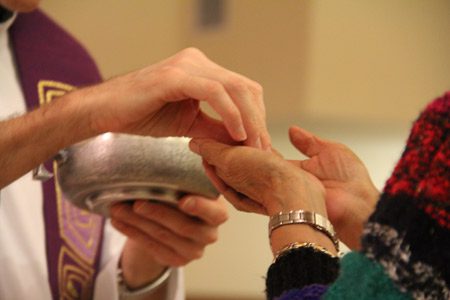The Office of Liturgy offers the following suggestions regarding the Sign of Peace and Communion from the Cup or Chalice during the cold and flu season.
The Rite of Peace
The Rite of Peace is part of the Roman Catholic Mass. According to the General Instruction of the Roman Missal (GIRM):
82. The Rite of peace follows [the Lord’s Prayer], by which the Church asks for peace and unity for herself and for the whole human family, and the faithful express to each other their ecclesial communion and mutual charity before communicating in the Sacrament.
While the Order of Mass uses the term “if appropriate” regarding the invitation to exchange the sign of peace, this rubric seems to pale when taking into account the historic nature of the first Christians exchanging the sign of peace at the Eucharist as well as other sections of the GIRM that suppose or imply the sign of peace will be given. (C.f. 82, 239) The invitation to offer a sign that is meant to express “ecclesial communion and mutual charity” (GIRM 82) could hardly be seen as inappropriate except in extreme circumstances. In such extreme instances there are still options available that would preclude the omission of the exchange of peace.
Since the General Instruction of the Roman Missal does not specify a particular manner of offering a sign of peace, and since even under ordinary circumstances some people are not able to shake hands due to medical conditions, one might choose among a number of other options instead of shaking hands to:
- Make a reverential bow of the head to the people around you and say, “Peace be with you.”
- Simply say “Peace be with you” without any gesture.
Distribution of Communion Under Both Kinds
Pastors are strongly encouraged to continue to offer Holy Communion in its “fuller form” (GIRM 281) of consecrated bread and wine.
- If the Priest celebrant’s health is compromised by cold or flu, then the priest’s chalice should be restricted to him only and not used to distribute the Precious Blood to other ministers or the assembly. Additional chalices should be used for common distribution.
- It is the decision of each individual communicant to receive the Precious Blood. Always keep in mind that some communicants may ONLY receive from the cup because of particular medical conditions. Those who suspect symptoms that may signal impending flu or cold should refrain from receiving the Precious Blood and receive only the Body of Christ in the species of the consecrated host until the person is well again.
- Extraordinary Ministers of Holy Communion should practice good hygiene before leaving their seat to minister communion. It is not recommended for EMHCs to ritualize the act of hand washing or sanitizing at the credence table or in the sanctuary since it is distracting and unsightly. EMHCs could carry a small alcohol-based hand gel and use it at their seat immediately following the Sign of Peace before they approach the altar to perform their ministry.
- Sacristans and others who hygienically wash the vessels after the have been ritually purified should be sure to use soap and hot water to wash the vessels.
Personal prudence and responsibility should always prevail when individuals are experiencing illness or a compromised immune system.

